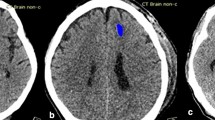Abstract
Purpose
To analyze the implementation of deep learning software for the detection and worklist prioritization of acute intracranial hemorrhage on non-contrast head CT (NCCT) in various clinical settings at an academic medical center.
Methods
Urgent NCCT scans were reviewed by the Aidoc (Tel Aviv, Israel) neural network software. All cases flagged by the software as positive for acute intracranial hemorrhage on the neuroradiology worklist were prospectively included in this assessment. The scans were classified regarding presence and type of hemorrhage, whether these were initial or follow-up scans, and patient visit location, including trauma/emergency, inpatient, and outpatient departments.
Results
During the 2 months of enrollment, 373 NCCT scans were flagged by the Aidoc software for possible intracranial hemorrhage out of 2011 scans analyzed (18.5%). Among the flagged cases, 275 (72.4%) were positive; 290 (77.7%) were inpatient cases, 75 (20.1%) were trauma/emergency cases, and eight (2.1%) were outpatient cases, and 229 of 373 (62.5%) were follow-up cases, of which 219 (95.6%) inpatient cases. Among the 144 new cases flagged for hemorrhage, 66 (44.4%) were positive, of which 39 (58.2%) were trauma/emergency cases. The overall sensitivity, specificity, positive predictive value, negative predictive value, and accuracy were 88.7%, 94.2% and 73.7%, 97.7%, and 93.4%, respectively. The accuracy of the intracranial hemorrhage detection was significantly higher for emergency cases than for inpatient cases (96.5% versus 89.4%).
Conclusion
This study reveals that the performance of the deep learning software for acute intracranial hemorrhage detection varies depending upon the patient visit location. Furthermore, a substantial portion of flagged cases were follow-up exams, the majority of which were inpatient exams. These findings can help optimize the artificial intelligence-driven clincical workflow.


Similar content being viewed by others
Abbreviations
- ED:
-
Emergency department
- ICH:
-
Intracranial hemorrhage
- NCCT:
-
Non-contrast head CT
References
van Asch CJJ, Luitse MJA, Rinkel GJE, van der Tweel I, Algra A, Klijn CJM (2010) Incidence, case fatality, and functional outcome of intracerebral haemorrhage over time, according to age, sex, and ethnic origin: a systematic review and meta-analysis. Lancet Neurol 9:167–176
Heit JJ, Iv M, Wintermark M (2017) Imaging of intracranial hemorrhage. J Stroke 19:11–27
Carter JA, Curry W (2017) Intracerebral hemorrhage: pathophysiology and management for generalists. Hosp Med Clin 6:95–111
Zahuranec DB, Lisabeth LD, Sánchez BN et al (2014) Intracerebral hemorrhage mortality is not changing despite declining incidence. Neurology 82:2180
Elliott J, Smith M (2010) The acute management of intracerebral hemorrhage: a clinical review. Anesth Analg 110:1419–1427
Fujitsu K, Muramoto M, Ikeda Y, Inada Y, Kim I, Kuwabara T (1990) Indications for surgical treatment of putaminal hemorrhage. 73:518
McDonald RJ, Schwartz KM, Eckel LJ, Diehn FE, Hunt CH, Bartholmai BJ, Erickson BJ, Kallmes DF (2015) The effects of changes in utilization and technological advancements of cross-sectional imaging on radiologist workload. Acad Radiol 22:1191–1198
Chilamkurthy S, Ghosh R, Tanamala S, Biviji M, Campeau NG, Venugopal VK, Mahajan V, Rao P, Warier P (2018) Deep learning algorithms for detection of critical findings in head CT scans: a retrospective study. Lancet. 392:2388–2396
Ojeda P, Zawaideh M, Mossa-Basha M, Haynor D et al The utility of deep learning: evaluation of a convolutional neural network for detection of intracranial bleeds on non-contrast head computed tomography studies. SPIE Medical Imaging, 2019, Proceedings Volume 10949, Medical Imaging 2019: Image Processing; 109493J
Arbabshirani MR, Fornwalt BK, Mongelluzzo GJ et al (2018) Advanced machine learning in action: identification of intracranial hemorrhage on computed tomography scans of the head with clinical workflow integration. npj Digit Med 1:9
Al-Ayyoub M, Alawad D, Al-Darabsah K et al (2013) Automatic detection and classification of brain hemorrhages. WSEAS Trans Comput 10:395–405
Funding
None
Author information
Authors and Affiliations
Corresponding author
Ethics declarations
Conflict of interest
The author declares no conflict of interest.
Ethical approval
The study was approved by the Office of Clinical Effectiveness of the University of Chicago, Chicago, USA.
Informed consent
For this type of study formal consent is not required.
Additional information
Publisher’s note
Springer Nature remains neutral with regard to jurisdictional claims in published maps and institutional affiliations.
Rights and permissions
About this article
Cite this article
Ginat, D.T. Analysis of head CT scans flagged by deep learning software for acute intracranial hemorrhage. Neuroradiology 62, 335–340 (2020). https://doi.org/10.1007/s00234-019-02330-w
Received:
Accepted:
Published:
Issue Date:
DOI: https://doi.org/10.1007/s00234-019-02330-w




